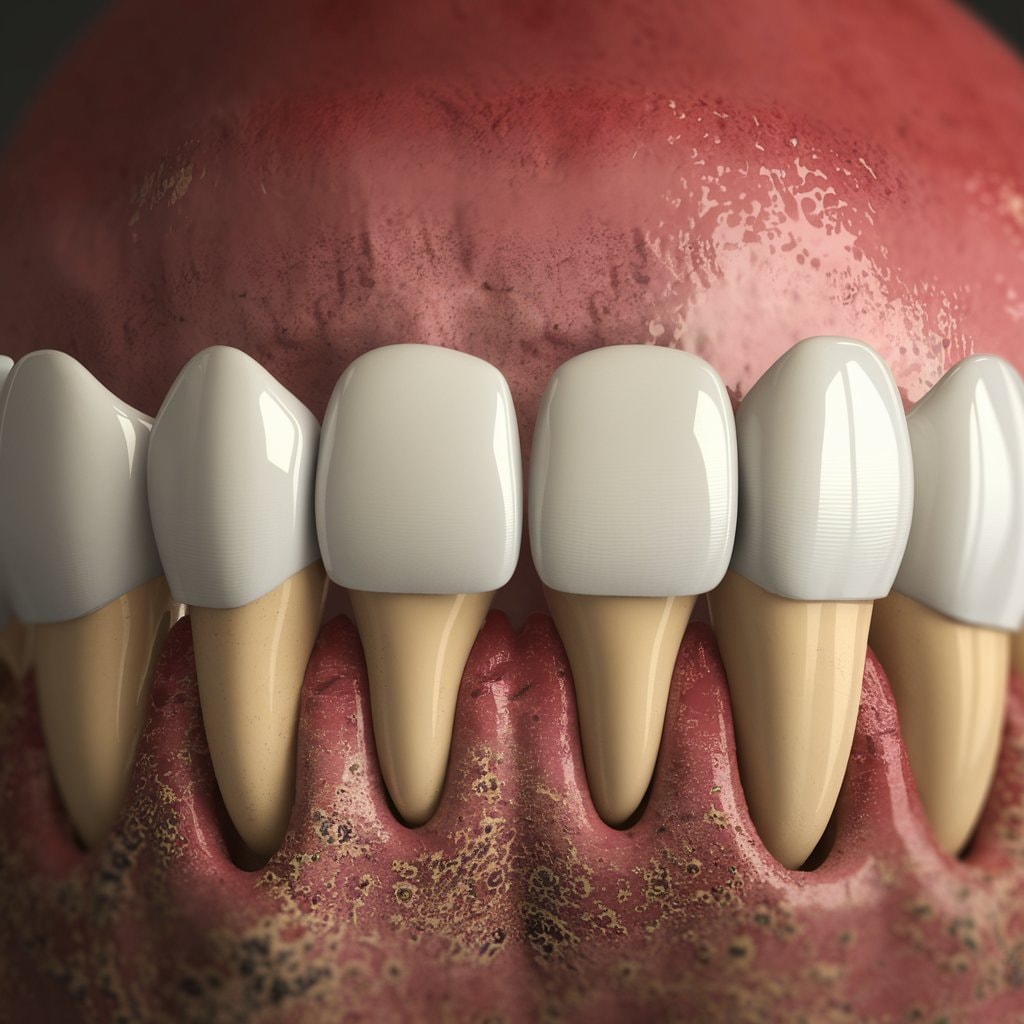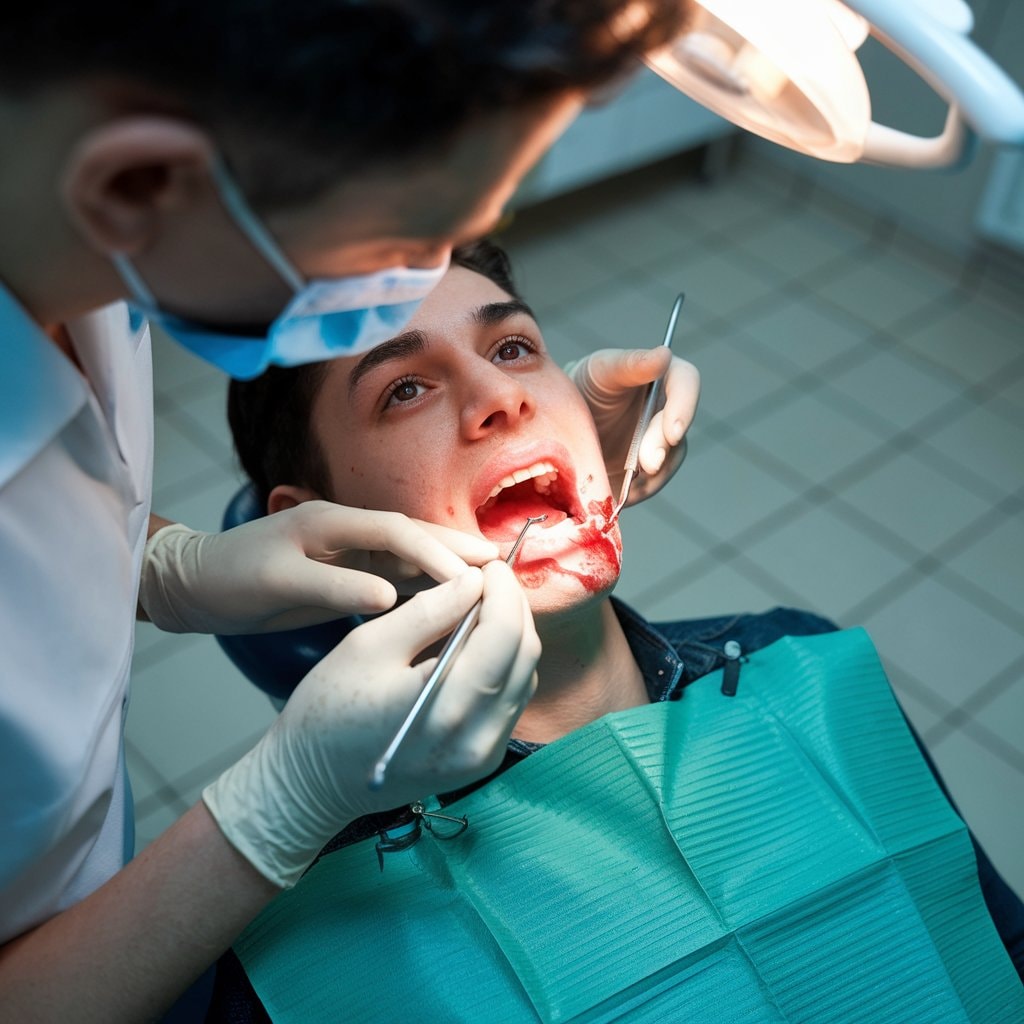Noticing blood when brushing your teeth can be alarming. Many people experience bleeding gums but often ignore it, thinking it will go away on its own. This common problem could be a sign of gum disease or inflammation.
If left untreated, it can lead to more severe health issues, including tooth loss.
One critical fact is that good oral hygiene plays a crucial role in preventing and managing gum bleeding. Our article provides practical advice and what is the treatment of gum bleeding to stop bleeding gums effectively.
We cover everything from daily brushing routines to seeking dental care for advanced cases of gum disease. Keep reading to discover how to keep your gums healthy and strong.
What Causes Bleeding Gums?
Poor dental hygiene stands as the main cause of bleeding gums, inviting plaque buildup along the gum line. Plaque hardens into tartar, leading to inflammation and bleeding of the gums.
Ignoring these early signs can escalate into severe gum disease or periodontitis. Regularly missing teeth cleaning sessions allow bacteria to thrive, producing acids that harm gum tissue.
Other factors also contribute to this problem. Habits like smoking heavily impact oral health, causing gums to become more susceptible to bleeding. Certain health conditions, such as diabetes and vitamin C deficiency, can weaken gums and lead them to bleed easily.
Using a toothbrush with hard bristles might damage the delicate gum line, while incorrect flossing techniques could lead to cuts and bleeding.
Good oral care is key in preventing gum disease.
Main Cause of Bleeding Gums
The primary cause of bleeding gums is typically linked to plaque buildup on the teeth. This sticky film contains bacteria that attack the gum tissue, leading to inflammation and bleeding when you brush or floss.
Ignoring this can escalate into more severe conditions like gingivitis, which is the initial stage of gum disease. Regular dental checkups help catch these signs early.
Good oral hygiene plays a crucial role in preventing plaque from causing harm. Brushing your teeth regularly with fluoride toothpaste and using interdental brushes or floss removes plaque before it can irritate your gums.
Making a habit of visiting your dentist for professional cleanings also prevents plaque buildup, keeping your gums healthy and stopping them from bleeding.
Other Possible Causes of Bleeding Gums
Certain medications can make gums more likely to bleed. This includes blood thinners, which reduce the blood’s ability to clot. When people brush or floss their teeth, they might notice more bleeding than usual due to these medications affecting their gums.
Vitamin deficiencies are another culprit behind bleeding gums. Lacking enough vitamin C and K in your diet can weaken gum health, leading to easier bleeding when brushing or doing dental care.
Hormonal changes during pregnancy can make the gums more sensitive to bleeding. It’s a condition known as pregnancy gingivitis and highlights the need for extra oral care during this time.
Besides these factors, diseases like diabetes that affect the body’s ability to use blood sugar may increase the risk of developing infections, including those in the gums, causing them to bleed easily.
Good oral hygiene plays a critical role in managing these risks.
Role of Plaque and Gingivitis in Gum Bleeding
Moving beyond other potential triggers, plaque buildup and gingivitis stand out as significant culprits behind bleeding gums. Plaque, a sticky film of bacteria that continuously builds up on teeth, is the main cause of gum problems.
If not removed daily through brushing and flossing, it can harden into tartar. Tartar provides a breeding ground for further plaque buildup near the gumline, leading to inflamed gums—a condition known as gingivitis.
Gingivitis is the early stage of gum disease and is usually reversible with good dental care. It manifests through symptoms like swollen gums and bleeding during brushing or flossing.
Ignoring these signs enables gingivitis to progress to more severe forms of periodontal disease, causing increased inflammation and even tooth loss. Regular dental checkups help detect these issues early on and prevent advanced gum disease.

How Can Good Oral Hygiene Help?
Maintaining good oral hygiene is essential in deterring gum disease and halting gum bleeding. Twice-a-day brushing eliminates plaque, the principal offender causing gum inflammation and bleeding.
Regular flossing accesses those hard-to-reach areas unattended by your toothbrush, thereby lessening the chance of gum discomfort and inflammation. Selecting the right toothbrush for your gums can make a marked difference.
Soft bristles treat sensitive areas kindly, avoiding unnecessary irritation that may result in bleeding.
Preventive measures such as correct brushing and flossing are essential for achieving healthy gums.
Besides everyday care, seeking dental checkups on a regular basis facilitates the removal of any plaque accumulation that might have been overlooked. This professional clean-up plays a significant role in preventing serious forms of gum disease that result in gum bleeding during brushing or even spontaneously.
Undertaking these practices improves oral health and promotes overall well-being by lessening the risks associated with lackluster dental hygiene, like heart disease related to chronic inflammation from gum-related issues.
Importance of Brushing Twice a Day
Brushing your teeth twice a day plays a crucial role in preventing gum disease and stopping gums from bleeding. This simple routine removes plaque buildup, which can lead to gum inflammation and bleeding.
If you ignore bleeding gums, plaque hardens into tartar—a much tougher substance that only a dental hygienist can remove during regular dental checkups. Brushing in the morning fights off bacteria that multiply overnight, while evening brushing clears away the day’s food particles and plaque.
Proper flossing complements brushing by targeting areas between teeth where brushes can’t reach. Together, they form an effective defence against receding gums, bad breath, and other symptoms of gum disease.
Treating bleeding gums starts with these fundamental oral hygiene practices before moving on to professional care or home remedies for more advanced issues.
Proper Flossing Techniques to Prevent Gum Bleeding
Proper flossing is essential in preventing bleeding gums as it eliminates plaque that brushing alone isn’t capable of removing. Here are some simple steps:
- Select the appropriate floss for your teeth and gums. Waxed types glide between teeth easier and lessen the chance of gum injury.
- Tear roughly 18 inches of floss. Wind most of it around a middle finger and the remainder around your opposite middle finger.
- Clutch the floss tightly between thumbs and forefingers, keeping about 1-2 inches between them for control.
- Carefully guide the floss between two teeth with a back-and-forth movement.
- As you approach the gum line, curve the floss into a ‘C’ shape against a tooth. Slide it into the space between your gum and tooth until resistance is felt.
- Without irritating or cutting your gums, move the floss up and down against the tooth to dislodge plaque.
- Repeat the process for each tooth, making sure to use fresh sections of floss.
- Avoid jerking or forcing the floss, as this can cause gum damage and bleeding.
- If handling regular string floss is challenging, consider using a floss pick, water irrigator, or an interdental brush made to deter gum disease.
- Following flossing, rinse your mouth to get rid of any dislodged food or plaque.
Routine dentist appointments can assist in detecting early symptoms of gum disease before they escalate into significant issues like tooth loss or severe gum disease forms with more prevalent symptoms like bleeding, pain, and inflammation. These could be avoided with early care, such as regular dental checkups and good oral hygiene practices, including effective brushing and the correct flossing techniques outlined here. These actions are key to preventing bleeding gums treatment, promoting healthier teeth over time, contributing to a happy smile, and improving oral health wellness.
Practicing good oral hygiene benefits everyone, from dental patients to caregivers and individuals interested in maintaining high personal hygiene standards. The strategies provided are easy to follow, irrespective of age, and contribute to preventing common dental issues, such as bleeding gums. Following these steps consistently leads to healthier and happier smiles, improving quality of life, and yielding significant developments over time in oral health matters.
Choosing the Right Toothbrush for Gums
Selecting the right toothbrush is critical for preventing gum disease and stopping bleeding gums. A soft-bristled brush is best because it won’t harm your gums or cause them to bleed.
This type of toothbrush helps remove plaque without damaging your gums, which is key to maintaining healthy teeth and gums.
Using a quality toothbrush plays a big part in good oral hygiene practices. It’s not just about brushing twice a day; it’s also about making sure you use a toothbrush that does the job well without harming your mouth.
Changing your toothbrush every three to four months ensures its effectiveness in cleaning and keeping gum inflammation down.
When Should You See a Dentist?
You need to visit your dentist regularly, not just when you experience discomfort or bleeding. However, specific signs indicate more urgent dental attention is necessary. If your gums bleed when you brush or floss, it could signal gum disease or inflammation of the gums.
Other red flags include:
- Persistent bad breath.
- Swollen gums that hurt.
- Any changes in how your teeth fit together when you bite.
Dentists have the tools to diagnose the cause of your bleeding and determine if you’re developing gum disease or if a different issue like plaque buildup is at fault. They can offer professional treatment options for bleeding gums that go beyond home remedies.
Regular dental checkups help prevent gum disease by catching potential problems early and providing appropriate treatment before issues become severe.
Signs That Indicate You Need Dental Attention
Gums bleeding during brushing or flossing is a common sign you need dental attention. This symptom often points to gum disease or plaque buildup, both of which can lead to more severe conditions if ignored.
Regular dental checkups are essential for diagnosing and preventing such issues early on. Another indication is persistent bad breath or a bad taste in your mouth, which could signify gingivitis, an early form of gum disease.
Painful gums, sensitivity to hot and cold foods, and teeth that feel loose without any visible cause also demand prompt evaluation by a dentist. These symptoms might indicate advanced gum disease or even tooth decay.
Ignoring these signs can result in the development of severe gum disease, leading to tooth loss or other health problems linked to periodontal disease. Identifying the cause of your bleeding gums early can provide effective treatment options and prevent further damage.
How Dentists Diagnose Gum Disease
Dentists employ various methods to detect gum disease, ensuring patients receive the correct treatment they require. Initially, a visual examination enables them to identify signs of inflammation and gum bleeding.
They can probe the gums using a minor rule to measure possible pockets around your teeth; deep pockets indicate advanced gum disease. X-rays assist dentists in identifying any bone loss around the teeth, another crucial sign of periodontal troubles.
Periodic dental checkups are efficient in detecting gum disease at an early stage before it escalates to grave issues.
Furthermore, dentists might inquire about your medical history to pinpoint any elements that could lead to gum disease, like smoking or diabetes. It’s common practice for dentists to educate patients about the importance of good oral hygiene in preventing symptoms such as bleeding gums associated with this ailment.
With such exhaustive measures, dentists diagnose and also strategize effective treatments for halting gum bleeding and reversing damage induced by periodontal diseases.

Professional Treatment Options for Bleeding Gums
After diagnosing gum disease, your dentist may suggest several professional treatment options to stop bleeding gums. One common approach is a deep cleaning procedure known as scaling and root planning.
This method removes plaque and tartar from below the gumline, addressing the buildup that causes bleeding and inflammation. For severe cases, dentists might recommend more advanced treatments like laser therapy or surgery to reduce pocket depth and restore healthy gums.
Your dentist will also stress the importance of regular dental checkups to prevent bleeding gums from progressing into more serious conditions. They might prescribe special mouthwashes or topical treatments to control infection and promote healing in the gums.
Adopting these professional recommendations helps treat gum problems effectively and prevents future issues with oral health.
Can Home Remedies Stop Bleeding Gums?
Home remedies play a significant role in stopping bleeding gums, providing relief and aiding in overall gum health. Among these, rinsing with salt water stands out as a highly effective remedy.
This simple solution works by reducing bacteria, easing inflammation, and helping to heal sore tissues. Incorporating this practice into your daily oral hygiene routine could lead to noticeable improvements.
Exploring further into natural treatments, the use of essential oils like tea tree or peppermint oil has also gained attention for their antibacterial properties that contribute to healthier gums.
These options offer an accessible way to treat bleeding gums at home alongside maintaining good oral hygiene, including regular brushing and flossing. Transitioning now to prevention strategies will further help in keeping your gums healthy over the long term.
Using Salt Water as a Remedy
Salt water acts as a natural disinfectant. It helps to reduce the bacteria that can cause bleeding gums. Mixing a small amount of salt with warm water creates a simple yet effective mouth rinse that soothes inflamed gums and stops bleeding.
This remedy is easy for anyone to use at home.
Gargling with salt water can be an immediate way to help control bleeding gums, especially after dental procedures.
10 Home Remedies for Bleeding Gums
After discussing salt water as a remedy, let’s explore ten home remedies for bleeding gums. These methods can help stop gum bleeding and prevent further issues.
- Rinse with hydrogen peroxide solution to reduce inflammation and kill bacteria. Do not swallow the rinse.
- Apply crushed garlic mixed with a pinch of salt directly to the affected gums to harness its antimicrobial properties.
- Massage gums gently with coconut oil daily using clean fingers to fight bacteria due to its antimicrobial effects.
- Drink green tea once or twice a day to take advantage of its anti-inflammatory properties, which can soothe inflamed gums.
- Make a paste of turmeric and water, then apply it to your gums for its healing and antimicrobial benefits.
- Use an aloe vera gel rub on your gums to ease inflammation and aid in healing because of its antibacterial qualities.
- Chew on raw fruits and vegetables like apples or carrots to naturally clean your teeth and strengthen your gums.
- Swish sesame oil in your mouth for a few minutes daily before brushing, known as oil pulling, which removes toxins and reduces plaque buildup that leads to bleeding gums.
- Increase your intake of vitamin C-rich foods such as oranges, kiwis, and strawberries since vitamin C strengthens gum tissue.
- Consume more calcium-rich foods like milk, cheese, and yoghurt to fortify teeth and bones, ultimately supporting gum health.
Each of these remedies focuses on natural ways to treat bleeding gums at home by utilizing items commonly found in your pantry or fridge.
Natural Ways to Treat Bleeding Gums
Transitioning from popular home remedies, we now explore natural ways to treat bleeding gums. These methods can help stop the bleeding, reduce inflammation, and support overall gum health.
- Rinse with salt water daily to reduce gum swelling and kill bacteria. Mix one teaspoon of salt in a glass of warm water.
- Apply aloe vera directly to the gums. Its anti-inflammatory properties help soothe irritated gums.
- Chew on raw fruits and vegetables. This helps clean your teeth naturally and stimulates the gums.
- Use turmeric paste as a natural anti-inflammatory agent. Apply directly to the gums or use it as a toothpaste.
- Drink green tea every morning. Its antioxidants may reduce inflammation in the body, including the gums.
- Massage your gums gently with coconut oil. It has antimicrobial properties that can fight infection-causing bacteria.
- Increase your intake of vitamin C by eating oranges, strawberries, and kiwis. Vitamin C supports healthy gums.
- Have dairy products like cheese and yoghurt. They contain calcium that strengthens teeth and gums.
- Avoid smoking, as it is a major cause of severe gum disease. Smoking damages gum tissue and reduces blood flow to the gums.
- Stay hydrated by drinking plenty of water throughout the day. Water helps clean your mouth and removes food particles.
These natural ways offer additional options for those seeking to maintain healthy gums alongside regular dental checkups.
How to Prevent Gum Bleeding?
Maintaining a diet rich in vitamins and minerals can be crucial in preventing gum bleeding. Foods high in vitamin C and calcium support healthy gums, reducing the risk of developing gum disease.
It’s essential to understand what causes your gum problems. Smoking is a major cause that leads to bleeding gums, along with other issues like tooth decay or periodontal disease. Quitting smoking can significantly reduce the likelihood of these oral health issues.
Long-term strategies include regular dental checkups to catch signs of gum disease early. Dentists remove plaque buildup that causes inflammation and bleeding. Using quality toothbrushes designed for sensitive gums also helps prevent irritation that may lead to bleeding.
Flossing daily removes bacteria between teeth, where brushes can’t reach, further protecting your gums from disease and keeping them strong and healthy.

Maintaining Healthy Gums Through Diet
Eating the right foods can play a big part in keeping your gums healthy. Foods rich in vitamin C and calcium, for example, help your gums fight off infection and keep them strong. Crunchy fruits and vegetables such as apples, carrots, and celery also help clean your teeth as you eat them.
They remove bacteria that cause gum disease. On the other hand, sugary snacks should be limited because sugar builds up on your teeth and can lead to gum problems.
Drinking plenty of water throughout the day helps wash away food particles and reduces plaque buildup on your teeth. This effort prevents bleeding gums due to plaque-induced gingivitis.
Understanding the cause of your bleeding gums involves looking at diet as well as oral hygiene habits.
Understanding the Cause of Your Bleeding and Gum Problems
To get to the bottom of bleeding gums, it’s crucial to pinpoint the exact cause. Plaque buildup and inflammation are common causes of gum problems, leading directly to gingivitis—a mild form of gum disease.
If left unchecked, this can advance into periodontal disease, a more serious health issue where gums may recede or bleed regularly. Regular dental checkups play a vital role in identifying these early signs before they develop into more severe conditions.
Factors like poor oral hygiene, using a hard-bristled toothbrush, or not flossing enough contribute significantly to gum issues. Other elements such as smoking, certain medications, and underlying health conditions like diabetes or bleeding disorders can also make your gums susceptible to bleeding.
Engaging in proper brushing twice a day with fluoride toothpaste and adopting correct flossing techniques can help prevent plaque buildup and reduce the risk of gum disease considerably.
Long-term Strategies to Prevent Gum Disease
Understanding the cause of your bleeding and gum problems sets a solid foundation. Now, let’s focus on preventing gum disease for good. Embracing long-term strategies is crucial in this journey.
Regular dental checkups play a pivotal role here. They help catch early signs of gum disease, leading to timely treatment. This regular monitoring can prevent the condition from advancing to a more serious stage.
Establishing and maintaining good oral hygiene is another cornerstone strategy. It involves using quality toothpaste and changing your toothbrush every three months to fight plaque buildup effectively.
Proper brushing twice a day and flossing daily removes bacteria that could cause gums to bleed or become inflamed. Including foods rich in vitamins C and D in your diet can also support healthy gums by strengthening the immune system against infections that may lead to gum disease.
Conclusion
Dealing with bleeding gums means taking action and understanding the causes. Practicing good oral hygiene, like brushing your teeth twice a day and using quality flossing techniques, is crucial.
If your gums are bleeding, seek professional help from a dentist to discuss the best way to treat gum disease. Regular dental checkups play an essential role in preventing conditions that lead to gum bleeding.
Home remedies like salt water can provide temporary relief, but they’re not a long-term solution for gum disease or tooth decay. To keep gums healthy and prevent periodontal disease, focus on a balanced diet and learn what causes your gum problems.
Your efforts will pave the way toward better oral health and stop bleeding from the gums effectively.


